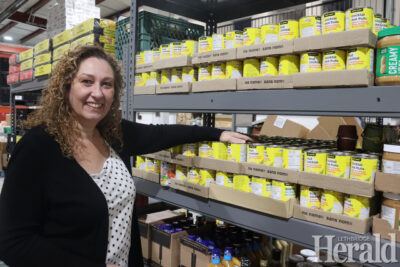Inflation hitting food banks
By Lethbridge Herald on December 1, 2023.
 Danielle McIntyre of the Interfaith Food Bank remains optimistic in community support as inflation has affected food banks in their abilities to assist clientele.
Herald photo by Al Beeber
Danielle McIntyre of the Interfaith Food Bank remains optimistic in community support as inflation has affected food banks in their abilities to assist clientele.
Herald photo by Al BeeberTheodora MacLeod – LETHBRIDGE HERALD – Local Journalism Initiative Reporter
It’s the word that has been on the lips of almost every Canadian for the past six months: inflation. From utilities, to housing, and especially groceries, costs are soaring, and Canadians are doing their best. But when it comes to the organizations that act as a safety net for those in times of need, inflation just keeps making it harder.
“We get hit on both sides,” says Danielle McIntyre, director at Interfaith Food Bank.
“More people can’t afford their groceries, so we have more people to serve, and that means we need more food to serve them with, and when groceries cost more that means we are also spending more on food.”
Initially, McIntyre says, the food bank was anticipating a seven to 11 per cent increase in cost, depending on the item. However, for some products, Canadians are seeing prices rise as much as 68 per cent. Unfortunately for food banks, the items seeing that leap are dry soups such as Cup-a Soup, and Ichiban noodles, products that were once considered affordable staples in cupboards and donation bins everywhere.
McIntyre explains that this spring, food hampers – which provide five to seven days of food – cost between $125 to $200 to put together, depending on the size of the hamper. By September – just six months later – those costs had risen to $175 for the small hamper and $250 for the large hamper.
In Food Banks Canada Poverty Index Report Card, Alberta was given an overall grade of D.
With nearly half of people surveyed saying they felt worse off financially than they had a year ago. The report card took into consideration factors such as social assistance programs –where Alberta received a failing grade– and costs of living.
It goes beyond just shelf prices, too.
“The majority of the food that we get is not community donations it is redirection of food so that it does it goes to people before it goes to garbage. When food is very expensive people are willing to pay for the less than perfect,” McIntyre explains.
Adding that things like old bread or distressed produce that would have once been passed over by shoppers and sent to food banks such as Interfaith, are now discounted and sold by the stores, “because people are willing to pay for it.”
But it’s not just large families or those with generational poverty working against them who are struggling.
McIntyre says the fastest growing demographic visiting food banks, is single adults who live alone.
“We have seen the faces of the people coming to the food banks change. Now we are seeing way more working people, we are seeing two income households, we are seeing retirees, people who shouldn’t need to be at our door are at our door now . . .having a job no longer means you don’t need to be at the food bank.”
She adds that many of the clients are making above minimum wage working and still struggling to get by.
Though the food bank did see a decrease in usage during the pandemic, thanks to programs like CERB, the number of current clients has exceeded those of the pre-pandemic.
Between mental health issues caused and exacerbated by the pandemic, supply chain interruptions due to international conflicts and extreme weather events, and government policies that impacts the cost of getting products to the province, McIntyre calls it “the perfect storm.”
While the demographics of the clients visiting the food banks are evolving, for those who have frequented the supports before, it’s just getting worse. “When times are tough, people who were already struggling are struggling even more,” says McIntyre.
“Until the last couple of years, we have never seen money going directly to food banks from governments, we had been eligible for government grants, but food security is a crisis,” she explains. With winter around the corner, that need is only set to rise. The cold weather leading to increased utility costs, people staying at home consuming more, and holiday gathers, all playing a role in the increase demand in support from food banks.
“We try to take the small wins where we can, we have to have faith in our community because food banks don’t have sustainable funding like most other non-profits,” she says, reminding anyone interested in donating that financial and monetary support can go much further than directly donating food products. “We are floated by donations; it is primarily community members that make food banks work.” And when it comes down to it, everyone has to eat.
But McIntyre has faith that the community will find a way to support the food bank as it has in the past. In fact, she suspects that as everyone feels the pinch of inflation, those who can donate will feel now more than ever how much impact their support makes for those in need.
“We will ride this wave out. Our community will support us as long as they have the ability to support us.”
23-22





Then make a donation to the food banks if you’re making 13 k a month. Directed at the bot on here bragging about making 13 k a month under some scam. Comment has been removed. 🤷♂️